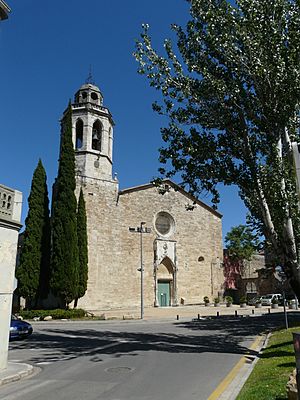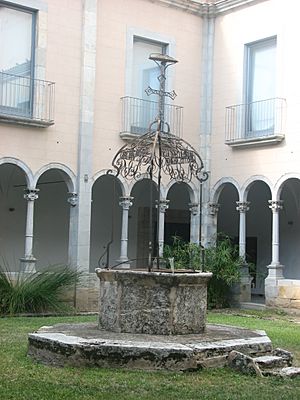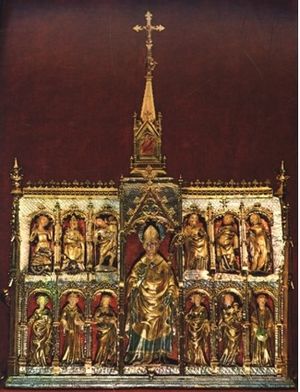Sant Esteve, Banyoles facts for kids
Sant Esteve de Banyoles is an old Benedictine monastery located in Banyoles, a town in Catalonia, Spain. A monastery is a special place where monks, who are religious men, live and work together. This monastery is so important that it was named a "Bé Cultural d'Interès Nacional" in 1973. This means it's a very important cultural landmark for the country. The monastery was first built a very long time ago, even before the year 812!
Contents
A Look Back: The Monastery's History
The Sant Esteve de Banyoles monastery was founded before 812. The first written record from the monastery is from 822. It was signed by an abbot named Bonitus. An abbot is the leader of a monastery.
The first people who lived in Banyoles settled around this monastery. For many centuries, the abbot of the monastery was like the ruler of the town.
The monastery buildings have been damaged many times over the years. Because of this, the buildings you see today are a mix of different styles. They show how the monastery was rebuilt and changed over time.
Attacks and Rebuilding
In the 10th century, the first church at the monastery was destroyed. This happened after it was attacked by invaders. In 957, a new church was dedicated. It had three special curved sections called apses.
In the 11th century, Sant Esteve was destroyed again. But it was rebuilt once more! A new dedication ceremony for the rebuilt monastery took place in 1086.
Earthquakes and Repairs
The entire monastery was also damaged by a big earthquake. This earthquake hit the area in 1427 and 1428. Later, in 1655, the bell tower and the cloister were destroyed. The cloister is an open courtyard, usually with covered walkways.
During the 17th century, a lot of repair work was done. A new bell tower was built between 1692 and 1699.
Exploring the Monastery's Design
The monastery's first cloister was built in 1086. It was in the Romanesque style, which is an older, sturdy building style. The main part of the church, called the nave, has three apses.
The front entrance of the monastery was built in the 16th century. It shows a style called late Gothic. This style is known for its detailed decorations. The rest of the building is from the 17th century and is in a style called Neoclassical. This style often looks back to ancient Greek and Roman designs.
Inside the Buildings
Besides the church, the monastery had other important buildings. These included a refectory (dining hall), a dormitory (sleeping area), a chapter house (meeting room), and housing for the monks. There was also a cellar, a barn, and a kitchen.
During a restoration of the cloister in 2003, some old Romanesque capitals were found. Capitals are the decorated tops of columns. These capitals are very important because they are from the 11th century. They also had paintings from the late Gothic period.
Amazing Art and Treasures
The Arqueta de Sant Martirià is a very special treasure. It is considered one of the most important gold artworks in the Girona area. This casket was made in the 15th century in the Gothic style. It holds the remains of Sant Martirià, who is the patron saint of Banyoles.
The casket is made of cypress wood and covered with silver. It looks like a small Gothic church. Seven silver-covered figures surround it.
Another important piece is the Altar of Our Lady of Scale. This altar was made in the mid-15th century. In the middle of the altar, there is a Gothic sculpture from the 15th century called Verge de l'Escala.
The monastery also has a beautiful Baroque organ. This organ was built in the 18th century and is located in the lobby.
See also
 In Spanish: Monasterio de San Esteban (Bañolas) para niños
In Spanish: Monasterio de San Esteban (Bañolas) para niños




